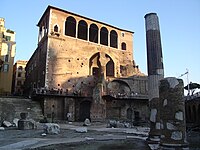■ Webster's online
loggia:
1. A roofed arcade or gallery with open sides stretching along the front or side of a building; often at an upper level.[Wordnet]
2. A roofed open gallery. It differs from a veranda in being more architectural, and in forming more decidedly a part of the main edifice to which it is attached; from a porch, in being intended not for entrance but for an out-of-door sitting-room.[Websters].
■ 다음백과(브리태니커)
로지아(loggia):
1면 이상의 면이 벽이 없이 트인 방 또는 홀·회랑·현관.
지중해 연안 지역에서 발달했으며, 탁 트였으면서도 햇빛을 가릴 수 있는 방을 만들려는 의도에서 비롯되었다. 고대 이집트의 많은 주택에는 지붕 위나 중정을 마주보는 실내에 여러 형태의 로지아가 있었다.
중세와 르네상스 이탈리아에서는 흔히 공공 광장과 연결되게 지었으며 대표적인 보기는 벤치 디 초네와 시모네 디 프란체스코가 지은 피렌체의 로지아 데이 란치(1376 착공)이다. 로지아는 또 빌라에는 없어서는 안될 부분으로, 훌륭한 장식이 덧붙여졌다. 로마에 있는 빌라 파르네시나의 로지아는 라파엘의 프레스코로 장식되어 있다.
■ Wikipedia, http://en.wikipedia.org/wiki/Loggia

Villa Godi by
Palladio. A loggia is the focal point in place of a portico in the centre, and used again at each side of the structure as a corridor.
The loggia can also be an alternative to the
portico. In this form it is most simply described as a recessed portico, or an internal room, with pierced walls and open to the elements. Occasionally a loggia is placed at the second floor level, above a loggia on the main floor; this is known as a 'double loggia'. Loggias sometimes were given significance in a facade by being surmounted by a
pediment.
The main difference between a loggia and a portico is the role within the functional layout of the building. The portico allows access to the inside from the exterior, and can be found on
vernacular and small scale buildings. The loggia is accessed only from inside, making it a place for leisure. Thus, it is found mainly on noble residences and public buildings.
Today, a loggia can be a small, often ornate, summer house built on the roof of a residence to enjoy cooling winds and admire the view. They are typical of Italian architecture and were especially popular in the 17th century. They are prominent in
Rome.
[edit]References
- Curl, James Stevens (paperback). A Dictionary of Architecture and Landscape Architecture (Second ed.). Oxford University Press. p. 880. ISBN 0-19-860678-8.
[edit]See also








댓글 없음:
댓글 쓰기